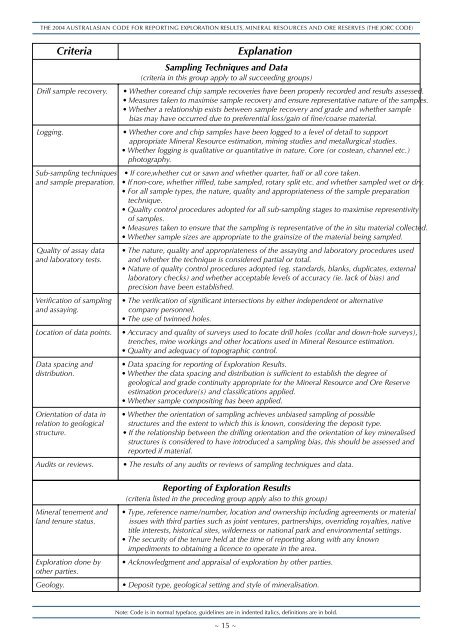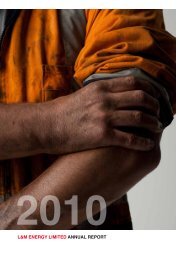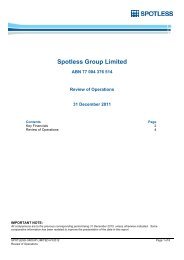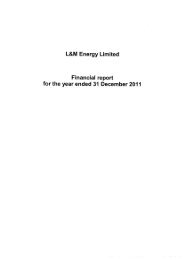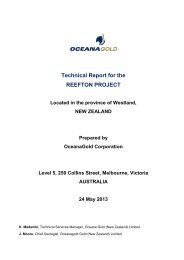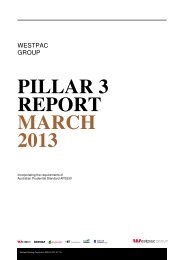NZSX/ NZDX Listing Rules APPENDIX 1 Part A (Rules 10.4.2 ... - NZX
NZSX/ NZDX Listing Rules APPENDIX 1 Part A (Rules 10.4.2 ... - NZX
NZSX/ NZDX Listing Rules APPENDIX 1 Part A (Rules 10.4.2 ... - NZX
You also want an ePaper? Increase the reach of your titles
YUMPU automatically turns print PDFs into web optimized ePapers that Google loves.
THE 2004 AUSTRALASIAN CODE FOR REPORTING EXPLORATION RESULTS, MINERAL RESOURCES AND ORE RESERVES (THE JORC CODE)<br />
Criteria<br />
Drill sample recovery.<br />
Logging.<br />
Sub-sampling techniques<br />
and sample preparation.<br />
Quality of assay data<br />
and laboratory tests.<br />
Verification of sampling<br />
and assaying.<br />
Location of data points.<br />
Data spacing and<br />
distribution.<br />
Orientation of data in<br />
relation to geological<br />
structure.<br />
Audits or reviews.<br />
Mineral tenement and<br />
land tenure status.<br />
Exploration done by<br />
other parties.<br />
Geology.<br />
Explanation<br />
Sampling Techniques and Data<br />
(criteria in this group apply to all succeeding groups)<br />
• Whether core and chip sample recoveries have been properly recorded and results assessed.<br />
• Measures taken to maximise sample recovery and ensure representative nature of the samples.<br />
• Whether a relationship exists between sample recovery and grade and whether sample<br />
bias may have occurred due to preferential loss/gain of fine/coarse material.<br />
• Whether core and chip samples have been logged to a level of detail to support<br />
appropriate Mineral Resource estimation, mining studies and metallurgical studies.<br />
• Whether logging is qualitative or quantitative in nature. Core (or costean, channel etc.)<br />
photography.<br />
• If core, whether cut or sawn and whether quarter, half or all core taken.<br />
• If non-core, whether riffled, tube sampled, rotary split etc. and whether sampled wet or dry.<br />
• For all sample types, the nature, quality and appropriateness of the sample preparation<br />
technique.<br />
• Quality control procedures adopted for all sub-sampling stages to maximise representivity<br />
of samples.<br />
• Measures taken to ensure that the sampling is representative of the in situ material collected.<br />
• Whether sample sizes are appropriate to the grainsize of the material being sampled.<br />
• The nature, quality and appropriateness of the assaying and laboratory procedures used<br />
and whether the technique is considered partial or total.<br />
• Nature of quality control procedures adopted (eg. standards, blanks, duplicates, external<br />
laboratory checks) and whether acceptable levels of accuracy (ie. lack of bias) and<br />
precision have been established.<br />
• The verification of significant intersections by either independent or alternative<br />
company personnel.<br />
• The use of twinned holes.<br />
• Accuracy and quality of surveys used to locate drill holes (collar and down-hole surveys),<br />
trenches, mine workings and other locations used in Mineral Resource estimation.<br />
• Quality and adequacy of topographic control.<br />
• Data spacing for reporting of Exploration Results.<br />
• Whether the data spacing and distribution is sufficient to establish the degree of<br />
geological and grade continuity appropriate for the Mineral Resource and Ore Reserve<br />
estimation procedure(s) and classifications applied.<br />
• Whether sample compositing has been applied.<br />
• Whether the orientation of sampling achieves unbiased sampling of possible<br />
structures and the extent to which this is known, considering the deposit type.<br />
• If the relationship between the drilling orientation and the orientation of key mineralised<br />
structures is considered to have introduced a sampling bias, this should be assessed and<br />
reported if material.<br />
• The results of any audits or reviews of sampling techniques and data.<br />
Reporting of Exploration Results<br />
(criteria listed in the preceding group apply also to this group)<br />
• Type, reference name/number, location and ownership including agreements or material<br />
issues with third parties such as joint ventures, partnerships, overriding royalties, native<br />
title interests, historical sites, wilderness or national park and environmental settings.<br />
• The security of the tenure held at the time of reporting along with any known<br />
impediments to obtaining a licence to operate in the area.<br />
• Acknowledgment and appraisal of exploration by other parties.<br />
• Deposit type, geological setting and style of mineralisation.<br />
Note: Code is in normal typeface, guidelines are in indented italics, definitions are in bold.<br />
~ 15 ~


